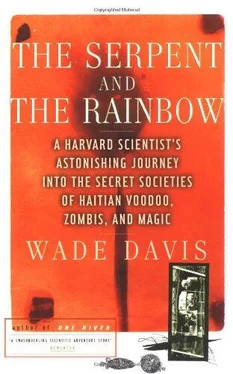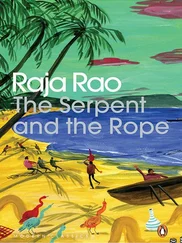Wade Davis - The Serpent and the Rainbow
Здесь есть возможность читать онлайн «Wade Davis - The Serpent and the Rainbow» весь текст электронной книги совершенно бесплатно (целиком полную версию без сокращений). В некоторых случаях можно слушать аудио, скачать через торрент в формате fb2 и присутствует краткое содержание. Год выпуска: 1985, Издательство: Simon & Schuster, Жанр: Старинная литература, на английском языке. Описание произведения, (предисловие) а так же отзывы посетителей доступны на портале библиотеки ЛибКат.
- Название:The Serpent and the Rainbow
- Автор:
- Издательство:Simon & Schuster
- Жанр:
- Год:1985
- ISBN:нет данных
- Рейтинг книги:5 / 5. Голосов: 1
-
Избранное:Добавить в избранное
- Отзывы:
-
Ваша оценка:
- 100
- 1
- 2
- 3
- 4
- 5
The Serpent and the Rainbow: краткое содержание, описание и аннотация
Предлагаем к чтению аннотацию, описание, краткое содержание или предисловие (зависит от того, что написал сам автор книги «The Serpent and the Rainbow»). Если вы не нашли необходимую информацию о книге — напишите в комментариях, мы постараемся отыскать её.
The Serpent and the Rainbow — читать онлайн бесплатно полную книгу (весь текст) целиком
Ниже представлен текст книги, разбитый по страницам. Система сохранения места последней прочитанной страницы, позволяет с удобством читать онлайн бесплатно книгу «The Serpent and the Rainbow», без необходимости каждый раз заново искать на чём Вы остановились. Поставьте закладку, и сможете в любой момент перейти на страницу, на которой закончили чтение.
Интервал:
Закладка:
First I tried to share with him a new notion of space. I spoke of mountainous valleys near my home in northern Canada, valleys larger than all of Haiti and totally uninhabited. I described moving through lands where space yielded in every direction to the infinite. I spoke of tundra vegetation at one’s feet, a cornucopia of color and sound, of whistles and birdcalls, of rust and ginger splashed onto a canvas that stretched to the horizon—and there, forests of mountains wrapped in icefields, seething masses of rock and ice in an ocean of clouds. I explained that between these two extremes, the minute flora and the gargantuan mountains, there was a complete dearth of man-sized objects. I tried to make Marcel envision a land where men were insignificant. It was perhaps the most difficult thing for him to understand. Then I spoke of temperatures, of lakes solid with ice, of damp clothing left out overnight and cracking the next morning like a stick. I described hunting animals, moose and caribou, speaking of the number of pounds of meat that each yielded. I spoke of wolves and bears, myths and legends passed on to me by the old hunting guides. Then I told him of the vision quest.
I explained how as a younger man I had been instructed to climb the highest peak in the valley, while the old Gitksan Indian waited below. I tried to carry Marcel up that mountain, describing in great detail the route, the steep scree and the ledges alive with goat, the dizzying exposures and the whirling landscapes of waterfalls and rock, spruce forests, and glaciers. I had him build with me, stone by stone, a rock cairn. I had him watch me as I sat alone on the summit, without food or water, until the animal came, what kind of animal I could never say. That animal arrives, I told Marcel, not by chance but because it was fated to become one’s protector—a spiritual guardian that might be called upon five or six times over the course of my lifetime. And so I explained to Marcel that I had my animal, and that was the reason I was not afraid of him. That was why I feared no man.
Once this came clear to Marcel, he became visibly excited. Quite by chance the vision quest I had experienced bore striking parallels to fundamental features of vodoun initiation. The hounsis canzo , or initiate, enters a week of seclusion in which he or she suffers a particular diet and rigorous prescribed activities, all supervised by an elder. At the end of a week the individual receives a spiritual name and enters the path of the loa, the divine horsemen. And so I finally made sense to Marcel. Later that day Rachel overheard him explaining to several of his people that this blanc was unlike the others because he had been initiated. It seemed a ridiculous way to go about things, he had told them, but that was the way people acted in the impossible land of Canada.
A pair of Marcel’s women lounged on the front steps of the Eagle Bar. His was an ugly trade, made worse by the innocence of the women at midday—their hair bound in curlers, their nails gleaming in fresh reds and purples—yet there remained something guiltless about Marcel’s establishment. One sensed that the Haitian men with their astonishing collection of wives, mistresses, and mamans petites had no shortage of outlets for their desire. They came to Marcel’s out of curiosity, sometimes to slake their flesh but most often just to gather. Behind the facade of bar and brothel the place had the atmosphere of a neighborhood club, informal and intimate.
Inside the bar Marcel and I celebrated our newfound trust by sharing a plate of rice and beans. Gleefully he explained in minute detail how he had bluffed me, recounting like a master storyteller each moment of our first encounter. He also instructed me in the application of the poison. As Kline had suggested, it could be spread in the form of a cross on the threshold of the victim’s doorway. But Marcel also said that it could be placed inside someone’s shoe, or down his or her back. This was the first indication that the poison might be applied directly to the intended victim. It made sense, of course, given my suspicion that there was no way any poison could get through the callused feet of a Haitian peasant. Moreover, placed on the ground at the entrance of the hut, it would presumably affect everyone who stepped on it, not just the intended victim.
With my confidence in Marcel reasonably established, my attention turned to the reputed antidote. Kline had mentioned several reports suggesting that a chemical antidote was administered to the zombi victim in the graveyard at the time of his resurrection. When I brought up the subject with Marcel, he remained equivocal. It was strictly the power of the bokor that revived the dormant zombi, he claimed. With two assistants the bokor would enter the cemetery, approach the grave, and call out the victim’s name. The zombi would come out of the ground unaided, be promptly beaten and bound, then led away into the night. His description coincided closely with the account of Clairvius Narcisse. Marcel went on to indicate that there was, however, a preparation that if used properly completely counteracted the effects of the poison. When I asked if he would be able to prepare it for us, he looked momentarily bewildered. Naturally, he replied, one would never make the poison without making the antidote. Marcel glanced toward Rachel as if I were the stupidest man alive.
That afternoon Jean dug up the young girl once more. After carefully placing the jars of poison in the coffin, he covered it over and retired to a corner of the hounfour. His work was momentarily finished. The poison would remain with the corpse for three days. Not surprisingly, it was Marcel, not Jean, who then mixed the ingredients of the antidote. He began by placing in a different and larger mortar several handfuls of dried or fresh leaves of six plants: aloe ( Aloe vera) , guaiac (Guaiacum officinale), cèdre (Cedrela odorata), bois ca-ca (Capparis cynophyllophora), bois chandelle (Amyris maritima) and cadavre gâté (Capparis sp.). This plant material was ground with a quarter-ounce of rock salt, then added to an enamel basin containing ten crushed mothballs, a cup of seawater, several ounces of clairin or cane alcohol, a bottle of perfume, and a quarter-liter of a solution purchased from the local apothecary and known as magie noire— black magic. Additional ingredients included ground human bones, shavings from a mule’s tibia and a dog’s skull, various colored and magically named talcs, ground match heads and sulphur powder. It was straightforward procedure, devoid of ritual or danger. The end product was a green liquid with a strong ammonia scent, similar to the substance that Marcel had been rubbing on us all along.
Below ground in the open court of the hounfour rested the child with the glass jars of poison cradled in her lap. Above ground one of the assistants placed lit candles at either end of the buried coffin, then traced in cornmeal a cabalistic design that bound the child’s new grave to the altar of the bagi. On the surface of the court he traced a second coffin and dissected it into fourths by drawing a cross. In each quadrant he drew the symbol of a spirit of the dead. Marcel poured the antidote into a rum bottle and placed it upright over the grave, its base buried in the earth, its mouth pointing to the sky.
Curiously, while the poison contained many ingredients with known pharmacological activity, the antidote was decidedly uninteresting from a chemical point of view. Most of the ingredients were either chemically inert or used in insufficient quantity. More importantly, the way that the antidote was applied strongly suggested that it had little to do with the actual raising of a zombi. It was only once somebody knew that he or she had become a victim of the poison that the antidote was administered, and it was applied simply as a topical rub. The antidote wasn’t intended to revive the victim from the dead; it merely prevented him or her from ultimately succumbing to the poison. And it did so according to a particular timetable. If a victim knew that he or she had been exposed to the poison no longer than fifteen days, they could simply administer the antidote. If, however, one had been subjected to the poison for more than fifteen days, the antidote had to be augmented by an elaborate ceremony in which the victim was symbolically buried alive. In other words, for severe cases it was not the antidote but a body of ritual and belief that was responsible for survival. A pharmacologically active antidote might still be discovered, but it was certainly not the one concocted by Marcel Pierre. Nor did he deny this. For him, the antidote was the power of his own magic.
Читать дальшеИнтервал:
Закладка:
Похожие книги на «The Serpent and the Rainbow»
Представляем Вашему вниманию похожие книги на «The Serpent and the Rainbow» списком для выбора. Мы отобрали схожую по названию и смыслу литературу в надежде предоставить читателям больше вариантов отыскать новые, интересные, ещё непрочитанные произведения.
Обсуждение, отзывы о книге «The Serpent and the Rainbow» и просто собственные мнения читателей. Оставьте ваши комментарии, напишите, что Вы думаете о произведении, его смысле или главных героях. Укажите что конкретно понравилось, а что нет, и почему Вы так считаете.












